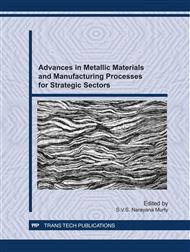[1]
R.S. Mishra, M.W. Mahoney, S.X. McFadden, N.A. Mara, A.K. Mukherjee, High strain rate super plasticity in a friction stir processed 7075 Al alloy, Scr. Mater. 42 (2000) 163-168.
DOI: 10.1016/s1359-6462(99)00329-2
Google Scholar
[2]
W.M. Thomas, E.D. Nicholas, J.C. Needham, M.G. Church, Templesmith, C.J. Dawes: Intl. Patent No. PCT/GB92/02203.
Google Scholar
[3]
G.W. Stachowiak, A.W. Batchelor, Engineering Tribology. Third ed., Elsevier, Singapore, 2005.
Google Scholar
[4]
Taoki, Zhou, Cui Hua, Zhang, Oxidation and hot corrosion behaviour of HVOF sprayed Nanostructure NiCrC coatings, Trans. Nonferr. Met. Soc. China. 19 (2009) 1151-1160.
DOI: 10.1016/s1003-6326(08)60421-5
Google Scholar
[5]
A. Nishimoto, K. Akamatsu, Microstructure and oxidation resistance of Fe3Al coatings on austenitic stainless steel by spark plasma sintering, Plasma Processes and Polymers, 6 (2009) s941-s943.
DOI: 10.1002/ppap.200932407
Google Scholar
[6]
Zhou Xiao-Lin, Yao Zheng-Jun, Gu Xue-Dong, Cong Wui, Zhang Ping-Ze, Microstructure and corrosion resistance of Fe-Al intermetallic coatings on 45 steel synthesised by double glow plasma surface alloying technology, Trans. Nonferrous Met. Soc. China, 19 (2009) 143-148.
DOI: 10.1016/s1003-6326(08)60242-3
Google Scholar
[7]
E.A. Brandes, G.B. Brook, Smithel's Metals Reference Handbook, 17th ed., Butterworths. 1999.
Google Scholar
[8]
L.E. Murr, A review of FSW research on dissimilar and alloy systems, J. Mater. Eng. and Perfor. 19 (2010) 1071-1085.
Google Scholar
[9]
R. Nandan, T. DebRoy, H.K.D.H. Bhadeshia, Recent advances in friction stir welding, Progress in Materials Science, 53 (2008) 980-1023.
DOI: 10.1016/j.pmatsci.2008.05.001
Google Scholar
[10]
R.S. Mishra, Z.Y. Ma, Friction stir welding and processing, Mat. Sci and Engg. R. 50 (2005) 1-78.
Google Scholar
[11]
Z.Y. Ma, Friction stir processing technology, A review, Met. & Matls. Trans. 39A (2008) 642-658.
Google Scholar
[12]
R. Rai, A. De, H.K.D.H. Bhadeshia, T. DebRoy, Review: Friction stir welding tools, Sci. and Techn. of Weld. and Joining, 16 (2011) 325-341.
DOI: 10.1179/1362171811y.0000000023
Google Scholar
[13]
Y.J. Chao, X. Qi, W. Tang, Heat Transfer in friction stir welding-Experimental and numerical studies, Trans. of the ASME, 125 (2003) 138-145.
DOI: 10.1115/1.1537741
Google Scholar
[14]
S. Cui, Z.W Chen, J.D. Robson, A model relating tool torque and its associated power and specific energy to rotation and forward speeds during friction stir processing, Intl. J. of Machine Tools and Manuf. 50 (2010) 1023-1030.
DOI: 10.1016/j.ijmachtools.2010.09.005
Google Scholar


